Three Bultacos from the same Camp...
We take a look at the bikes... and must thank Riccardo Aime for providing the machines to test in 2019......
So the third in the "New to us" series of the Justyn's Norek trials tests...
And we get three machines in this one that span the BULTACO years from the seventies to the year 2000...
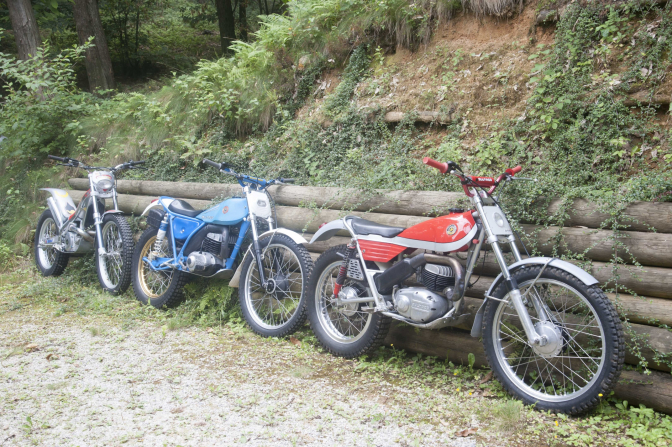
3 BULTACO TEST - And Riding impressions...
Riding impressions of 3 BULTACO TRIAL TEST by Justyn Norek Jnr:
This is comparative test trying to evaluate 3 generations of Bultaco trials bikes, and show progress in trials bikes construction.
BULTACO 80 from 1971.

All Photos Justyn Norek Snr... And his ©...
This bike is having beautiful combo of fuel tank integrated with seat base and side panels done fibreglass and attractively finished in Ferrari like red with all the rest in silver.
Handling is very good in all conditions and obstacles and I was very impressed by
Its capacity to climb over steep obstacles thanks to smooth power coming from
250cc engine and well tuned suspension by Riccardo, I imagine it was real hit
In 1970ties. Perfectly in one continuous line of fuel tank and seat profile makes it
Very comfortable when you slide forward.
When I found it more difficult was on tight turns also because handlebar was bit
High for me as Riccardo is taller than me. 2932 were produced.
All together an excellent bike, that is great pleasure to ride despite she is 46 years old !
~~~~~~~
BULTACO 199A BLUE from 1980.
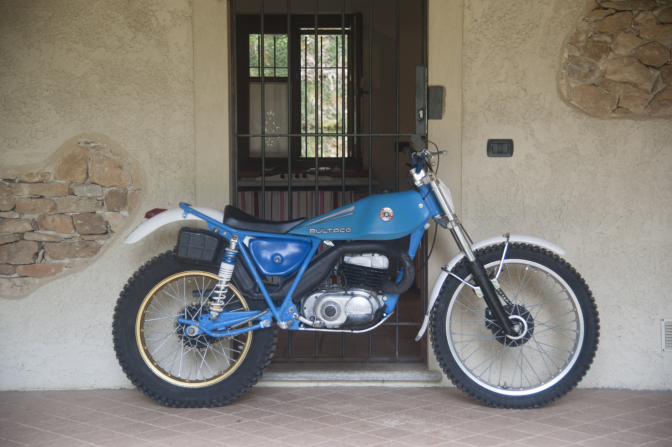
I really love this machine !
All in bright blue but white mudguards and silver engine, its also very attractive with
long slim fuel tank, flush with seat. One big point of this bike is great engine of 325cc
Capacity that propelled to so many wins such legendary riders like Martin Lampkin,
YRIO VESTERINEN, BERNIE SCHREIBER to mention few...
Everything seems to be perfect with this bike, specially engine which has great low
revs power and torque that allows you to ride clean over obstacles that you
wouldn't imagine you would pass over...
With 6915 produced no wonder it's so popular among old trial riders today...
~~~~~~~
BULTACO-SHERCO 1999.
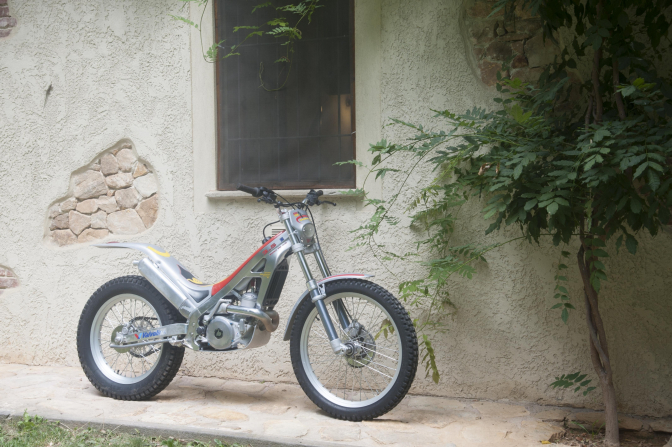
Bultaco reborn !
Great news for all Bultaco enthusiasts !
Thanks to Marc Teissier, another Bultaco lover, this great marque was reborn !
Even if later, name had to be changed to SHERCO which is very well respected
And successful company today.
This bike is really beautiful and modern with perimetrical rectangular tubes steel
Frame and compact liquid cooled engine.
I felt immediately at home on this bike, so satisfied with it that I wanted to buy it !
Unfortunately Riccardo gently turned down my offer....
No wonder why as its number 62 of only 150 produced its pretty rare.
Its very modern bike despite already 20 years old !
Great trio of trials bikes !
Justyn Norek Jnr...
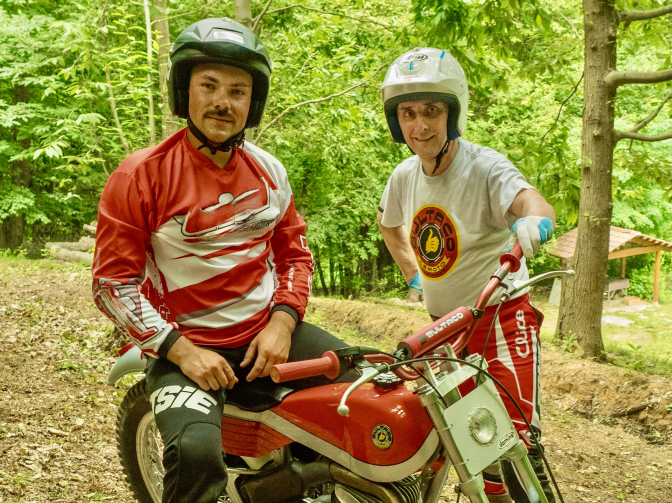
Justyn Norek Jnr with the three Bultaco's owner and pilot Riccardo Aime...
3 GENERATIONS OF BULTACO TRIAL - A WALK IN TIME
In this article we present 3 Bultaco trials, 3 generations of trial bikes that have marked their era, in particular the 2 older ones that have become true icons.
These motorcycles represent about 40 years of trial history and give us an idea of the technical evolution that the vehicles used for this sport have carried out from 1970 to 2000.
The motorcycles are part of my small "single-issue Bultaco trial" collection and are respectively an 80 model, the so-called "Slim Line" built in 1971, the 199A model, better known as the Bultaco Blu and finally the last vehicle built with the commercial name Bultaco, motorcycles that from the following year were marketed as Sherco.
We will therefore take a kind of walk in the "trial time" starting from a sturdy and heavy 2-stroke air-cooled motorcycle, drum brakes and little sophistication to get to a water-cooled vehicle, single shock absorber rear suspension, disc brakes and low weight. conceptually not very different from the modern means currently employed in the modern trial.
The motorcycles, in particular the two older ones, are not completely original as I normally use them to make trials including participation in the group 5 vintage trial championship and over time I have made changes which, while not upsetting the substance of the vehicles, have improved them. usability making them more suitable for the areas encountered in current vintage trials, and also those that we trace when we go to trial on Saturday afternoon.
So the purists of originality will forgive me if I illustrate means that are not completely equal to the production specifications but, as I have already said in previous articles, I do not have the spirit of the collector but I have a lot of fun walking around the areas with an "old lady ". I was born “trialistically” on a Bultaco Blu and in the end on a Blu I continue to ride and have fun.
~~~~~~~
Let's now pass to the description of the individual machines.
The oldest motorcycle examined is the model 80, the so-called “Campeon kit” or “Slim Line” built in 1971 and which, in Italy, represented an important step in the diffusion of the trial and of the Bultaco brand.
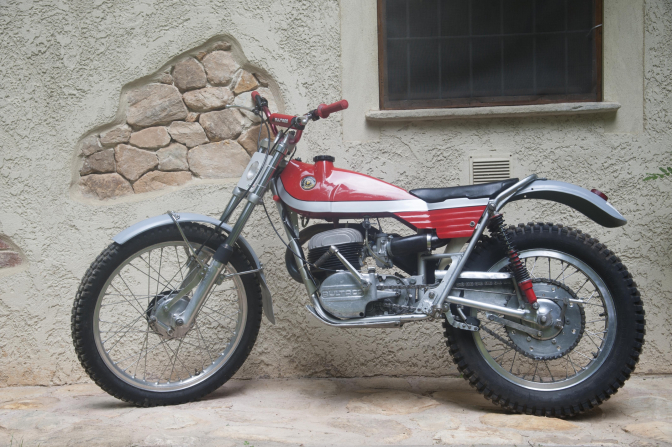
In my opinion, the beautiful one-piece tank saddle gives an aggressive and elegant line to the vehicle, making it today as in 1971, truly a vehicle to be desired.
Displacement is 250cc, air-cooled with 5-speed gearbox, practically in original condition with no changes except the longer clutch lever for smoother handling.
The frame is original except for a slight retraction and lowering of the foot-pegs, which are wider than the original ones and I mounted an aluminium plate ex Ossa to protect the lower part of the frame from impacts.
The fork is the Betor originally mounted while the shock absorbers are also Betor like the original equipment but are more robust and longer to raise the rear axle and gain ground clearance.
A colleague (thanks Michele !) made me a new fork head (Yoke) from solid with advanced handlebar stems like on modern trials and a couple of degrees less forks inclination; on this head a rather high handlebar has been mounted to have a posture not to curled up downwards.
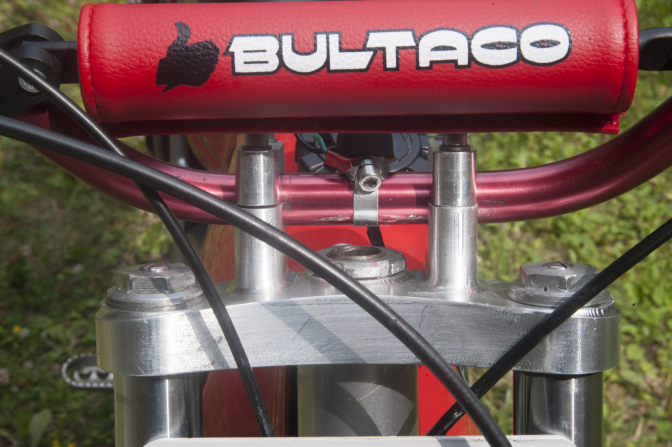
~~~~~~~
This solution associated with the lower footrests improves the handling characteristics of the vehicle making it a little more manageable and easy to use in tight curves, a situation that the vehicle in its initial configuration did not digest.
Always with a view to use, the electrical system has been dismantled leaving only the ignition circuit, the rear brake pedal has been moved to the right compared to the original assembly provided on the left with some acrobatics to make the brake side coexist on the same side and I change but, after a couple of trees hugged due to the brake pedal not found, this modification has become indispensable.
The muffler has been modified by increasing the diameter of the outlet pipe and also the final silencer has been modified, making the passages a little freer and giving the engine a little more vent. At the time of the test, a carburettor from a Bultaco model 158 was fitted but even with its original carburettor the engine performs well as long as the wear of the carburettor itself is acceptable.
The hubs are the original ones, with the friction tracks not yet chromed as in the vehicles subsequently produced. The front hub is not tapered and the most attentive will notice that the front rim is lowered and not raised as in the standard vehicle, a modification that allowed me half a kilo less on the front wheel. Michelin tires (Tyres) allow better traction even in the slimy stuff accompanying the sweetness of the shot motor…
~~~~~~~
The second motorcycle analysed in this report is the Bultaco 199A model, better known as the Bultaco Blu.
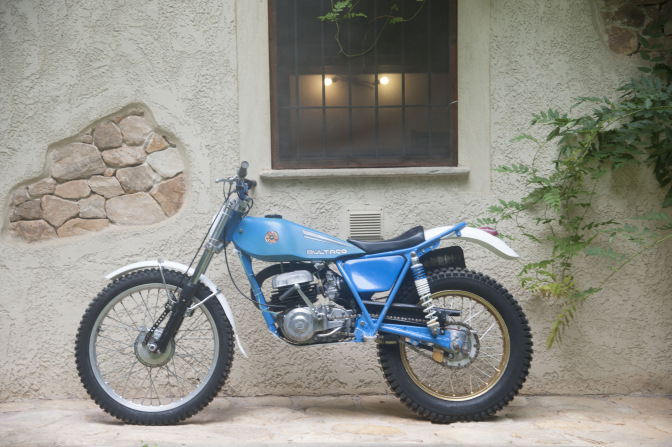
The service bike has undergone numerous modifications, many of which are inspired by what my friend Aldo Allione applied to his vehicle (see MCDE January 2017).
Starting from the chassis, the geometry has remained unchanged but the foot-pegs have been lowered and moved back to lower the centre of gravity to the advantage of the balance from standstill and the lightness of the front axle and also in this case my colleague built me a fork head (Yoke) with attachments advanced; in addition, to maintain the excellent response of the Betor fork, while improving handling in tight corners, the steering angle has been slightly closed, about one degree.
A pair of Magical shock absorbers allows a more modern response than the standard Betor, especially on the steps, "shooting" the rear of the bike upwards. A pair of Magical springs have slightly stiffened the fork's operation, avoiding excessive sinking in downhill curves,(Sections) a situation that has always put me in difficulty and that became dramatic with the “pack” fork due to the springs originally fitted, which were not very rigid.
With some stunts I mounted a Michelin X11 tubeless on a tube type rim but now, I have recovered an original hub but with a tubeless rim the situation has improved a lot; as a precaution, however, I still prefer to use the inner tube.
The brake compartment underwent rather radical interventions at the front by mounting a Grimeca ex SWM hub to replace the original hub characterised by the chromed braking surface whose effectiveness was never top and rapidly decayed as the chrome layer of the braking surface peeled off… The brake was mounted on the opposite side to the original assembly to improve the passage of the cable gaining effectiveness.
The rear brake control has been modified by adopting a rigid control (rod that crosses the engine support) to avoid the "sponginess" of the original cable control and consequently have greater precision in the "negotiated curves" while the rear shoe has the track braking in good condition and allows good braking.
As regards the engine, 3 “major” interventions were carried out on power supply, ignition and clutch and the connection of the head to the frame was also doubled to avoid the recurring breakage of the sheet metal bracket.
The carburettor was replaced by a flat valve Mikuni carburettor (dating back to 1995 that I had mounted on an Aprilia Climber) and the filter cassette was also replaced by a filter cassette from a model 159, a common practice on official motorcycles of the 'era, all for a better response of the engine. In fact, the Mikuni / coarse filter cassette mix gives the engine a roundness of operation and a sweetness of response that makes the vehicle rather easy to drive; with the original Bing carburettor the answer is more brutal and moreover I have never been able to find the right carburation…
The points ignition was replaced with an Electrexworld electronic ignition and from the moment of (easy) assembly all the starting difficulties have disappeared, points, capacitors, saints in heaven inconvenienced by various curses ...
Experts claim that the Ping ignition at very low revs is better than the electronic one and it is probably true but on my bike I kept the original flywheel after testing the flywheel of the 250 which gave a greater responsiveness of the engine but in the end I preferred to reassemble the heavy flywheel which rounds out the engine operation and fits better with my preferences in terms of driving.
The clutch has been modified by mounting driven discs from Fantic 240 which unlike the original iron discs have friction material which makes the detachment better and a behaviour more similar to a modern clutch. To improve the smoothness of the command, the shaft that pushes the control rod has been mounted on bushings.
A pair of white fenders,(Guards) the no longer matt black engine and a blue handlebar complete the “Schreiber replica” look.
I mainly use this bike that after years of continuous modifications I have "sewn on" and I enjoy using it; surely there are better bikes but this one is fine for my riding.
~~~~~~~
The third and last bike covered in this service is the latest trial bike produced under the Bultaco brand already owned by Sherco, which in 1999 entered the trial market with this model already branded with the double Bultaco / Sherco brand.
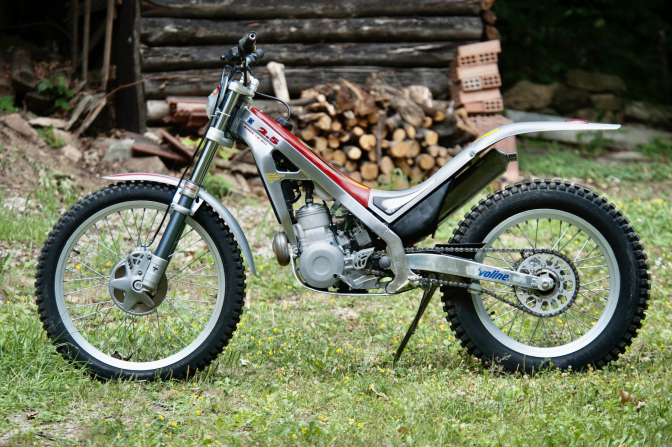
The motorcycle in my possession is part of a limited series of 150 motorcycles built to celebrate Graham Jarvis' victory at the Six Days of Scotland in 1999. The model is number 62 and is absolutely original except
for the foot-pegs that I replaced with a more "racing" model.
The vehicle despite being almost "twenty years old" still has many of the characteristics of today's 2-stroke trials except the displacement which today tends to be close to 300 cc while this vehicle has a displacement of 250 cc considered by the English trial school of the time to be a sufficient compromise between power and drivability.
On the bike we find water cooling, disc brakes, single shock absorber with link, hydraulic clutch, low weight, tubeless rear tire, geometry and set-up similar to today’s machines…
There is not much to add except that with this bike I participated a few years ago in a regional race in the "poor" category and I also won (one of my very rare victories).
The comic aspect was that many of the young competitors did not know what a Bultaco was and after having looked at it carefully they said: but it's a Sherco ! and go on and explain that Sherco is descended from Bultaco and not vice versa….
If you scroll through the rankings you will not even find my name associated with a Bultaco, at the registration when I declared the bike the commissioner asked me if I was racing on a vintage motorcycle but since it became complicated to explain the whole story I preferred to get registered on Sherco.
But it was the only time I betrayed the Bultaco brand, a faith for me !!
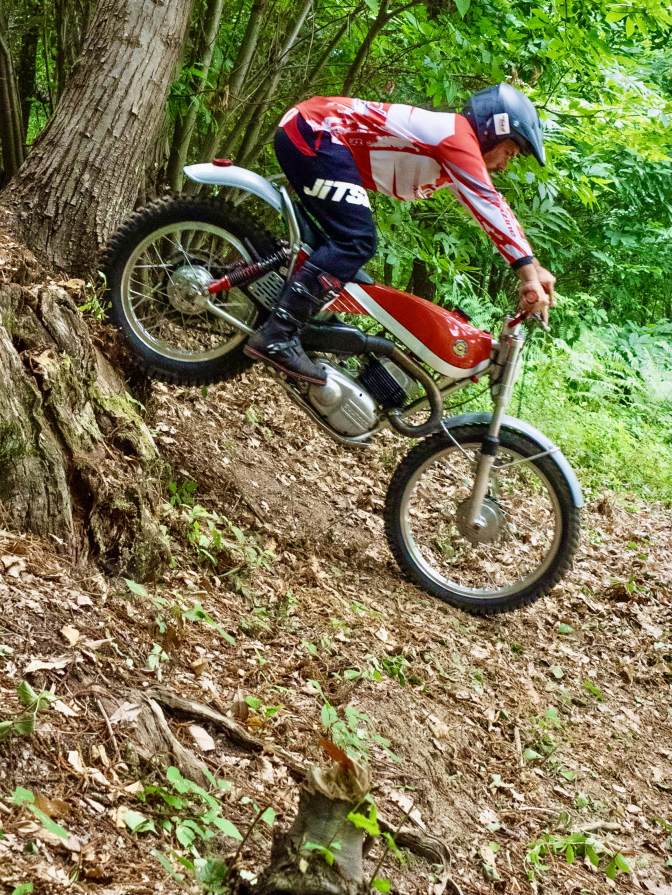
Justyn dives down an incline on the Bultaco Model 80...
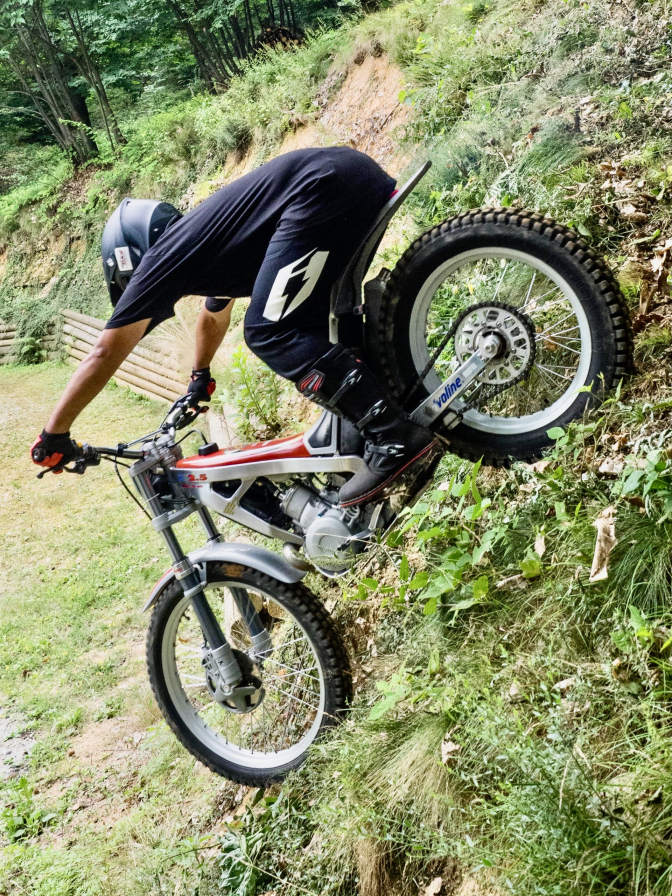
And does the same on the Bultaco-Sherco...
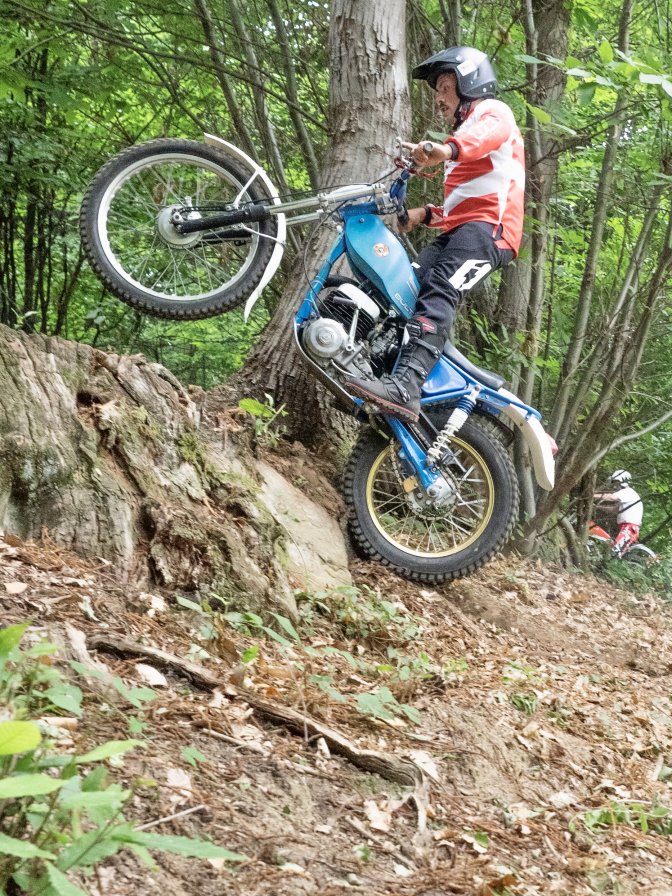
Justyn aboard Bultaco Blu...
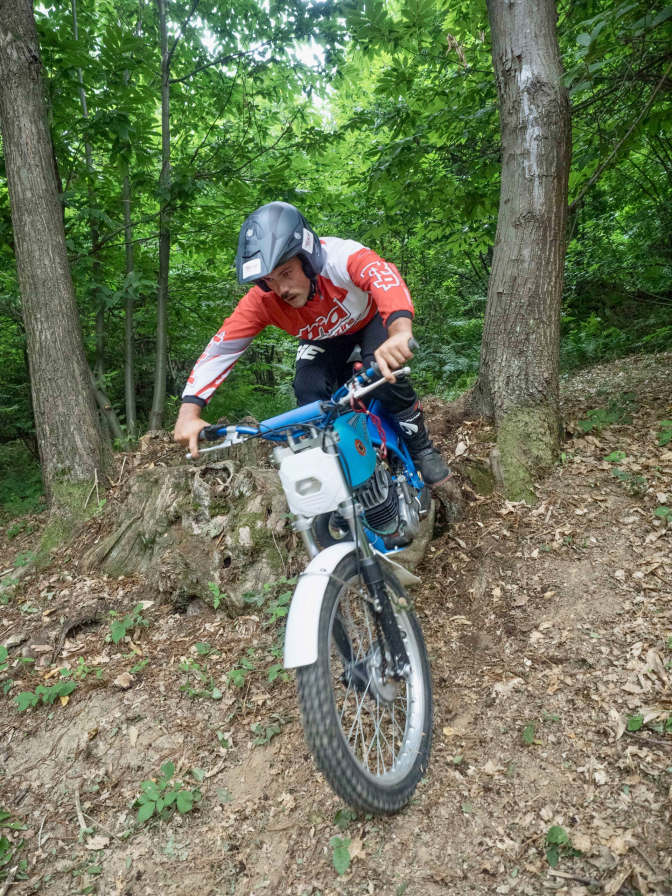
Then Up and down on the Bultaco 199A Blue...
More later on the specification of the machines...
Another "Norek" Trials bike test brought to you by...2022

updat2025...06...






